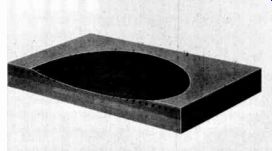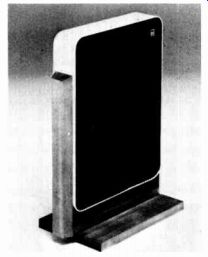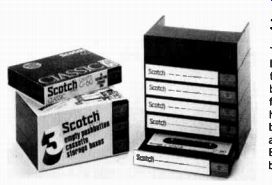
What Is a "Vertical FET"? With the announcement of the Yamaha power amplifier (see " Equipment in the News," June ' 75) and previous Sony products using "vertical FETs," yet another new phrase has entered the high fidelity lexicon. Readers presumably know at least that FET stands for field-effect transistor and that these devices have certain technical advantages over the more common bipolar transistors; but what does that word "vertical" imply? Thereby hangs the story of the FET amplifier as a practical reality.
Field-effect transistors, like vacuum tubes, are the electrostatic field of an applied, fluctuating voltage as a valve to control the quantity of current flowing, on an instant- by instant basis, through the device-from power supply to output. In conventional FETs the current path in the conductive film of the transistor passes between elements that hold the static " control" voltage, which alternately blocks off the current's passage or opens it up by means of the voltage's field effect within the conductive path.
There are limits to the physical size of the conductive path if it is to be kept within the control voltage's field, however; and this severely limits the current-and hence power-conventional FETs can handle. That's why, until recently, there have been no amplifiers that made use of the FET's performance superiority in power stages.
In the vertical FET the current passes through the thick ness of the conductive film-which therefore can be made as large in current-carrying cross section as it need be for the intended power capacity. The conductive film is studded with control-voltage elements, spaced so that their electrostatic fields will cover the whole cross-section area. The current passing through the field now is moving vertically through the thickness of the film, rather than "horizontally" along the film; hence the name and its implied importance where current and power requirements are high.

This model suggests construction of Yamaha vertical
FET. Dark "screening," visible
in center area and (in cross section) at the edges, is the control element.
Current must thread its way through this grid in passing from one surface
to the other of the main conductive element, the medium-gray upper layer.
Lighter gray portion below represents nonconductive substrate to support
working elements.
B.E.S. shuns cones, pistons, and enclosures
A line of loudspeakers operating on a novel principle and avoiding traditional types of cones, pistons, and enclosures is available from Bertagni Electroacoustic Systems, Inc., of California. Multiple drivers ( two to four, depending on the system) activate separate regions of a " pulsating plane," a pre-tensioned diaphragm made of a proprietary material called Soniflex. The units, which are relatively compact, are claimed to produce a wide spectrum, flat frequency response, low distortion, and a virtually spherical radiation pattern. Known as Geostatic speaker systems, they range in price from $129 to $ 499.

Spectro Acoustic introduces graphic equalizer
The Model 210 equalizer divides each channel into 10 frequency bands and allows 15 dB of boost or cut in each of the audible octaves. The unit uses active filters that avoid passive inductors with their sensitivity to magnetic fields and current saturation. The equalization settings, according to Spectro Acoustics, do not affect signal to noise ratio or increase distortion, and each channel is provided with over-all gain controls. The S/N ratio of the Model 210 is claimed to be greater than 90 dB below 2 volts rms, and the dynamic range extends over 100 dB below full output. A high voltage output stage is said to eliminate the need or meters or LEDs for input-output adjustments. The suggested list rice is $ 275.
Dynamic range expander from Pioneer
Pioneer High Fidelity has announced that its RG-1 dynamic range expander is ready for marketing. The unit, which restores transients and dynamic range to approximately those of the original program material, reduces the audibility of low-level noise at the same time. A switch al lows the user to adjust the degree of expansion between 6 and 14 dB in 2-dB steps to tailor the expander for any program material. If uncompressed material is to be played, expansion can be shut off. The RG-1 can be connected to any high fidelity component system via the tape out and tape-monitor jacks. An input control matches it to the components with which it is used. The cost is approximately $ 175.
Class D output is Infinity's new switch
Infinity Systems, Inc., has announced that its DSP (digital signal processing) switching amplifier is finally available for the consumer market. This unit employs class D amplification, in which the output transistors operate as high-speed switches, spending most of the time fully on or off. In class D the output transistors develop virtually no heat except during the off-to-on and on-to-off transition times-and these are extremely short. Thus the DSP amplifier is very efficient and can operate with a smaller than usual power supply and less heat sinking. And non linear behavior of the output transistors cannot cause distortion. The new model, compact and weighing a mere 35 pounds, is rated at 250 watts continuous power per channel and is credited with improved reliability. Its retail price is $1,850.
Community Electronics' new tower speaker
This four-way floor- standing speaker system features a ducted- port en closure design. Its drivers, according to Community Electronics, reduce failure and distortion due to excessive power at the frequency extremes. The CEI 124's piezoelectric supertweeter is claimed to improve transient response as well. Also including a 12- inch woofer, 3 1/2-inch mid range, and 1-inch dome tweeter, the model can be used with amplifiers rated up to 400 watts continuous power per channel. It has an impedance rating of 4 ohms. The speaker, which comes in an oiled walnut veneer cabinet, carries a per-unit price of $295.
Audio-processing components from Robins
The Integra 3 system from Robins-Fairchild consists of audio-processing components constructed on printed-circuit modules that can be interconnected so as to serve a wide variety of uses. The line includes filters, mixers, preamps with compressors or limiters, oscilloscopes, and remote gain controls. The Integra 3 modules can be purchased separately or as part of a factory-engineered console. Price differs according to the type of console, which may also be custom-designed. Separate modules can be used with standard mounting hardware.
3M markets cassette storage system
The C-Box cassette storage system featuring stackable and interlocking boxes and pushbutton drawers for quick cassette access is available from the 3M Company. An index label is provided on the front of each box, and there is a drawer insert card for detailed recording identification. Also available are a wall bracket for permanent mounting and a handle for easy toting. Scotch Classic C-60 and C-90 cassettes can be bought prepackaged in the C- Box components (or, for 30 cents less apiece, in the traditional Philips box). Bought as accessories, the C-Boxes cost $ 1.99 for a sleeve-pack of three empty units, and the wall bracket and carrying handle are 99 cents each.

-------------
(High Fidelity, Jan. 1976)
Also see:
Onkyo A-7 Integrated Amp (Equip. Profile, Nov. 1977)
Equipment Reports (Jan 1976)